May 18, 2025 | 18:22 GMT +7
May 18, 2025 | 18:22 GMT +7
Hotline: 0913.378.918
May 18, 2025 | 18:22 GMT +7
Hotline: 0913.378.918
The gray-shanked douc langur with the scientific name Pygathrix cinerea is one of 25 primate species classified as extremely endangered in the IUCN Red List. In particular, the langur only appears in Vietnamese forests. They are not only endemic species with unique beauty, but also have a very interesting life habit.
As a participant in the research group on gray-shanked douc langurs in Kon Ka Kinh National Park (Gia Lai) 16 years ago, Nguyen Ai Tam, said: “In the past, Kon Ka Kinh forest was the kingdom of gray- shanked douc langurs. At that time, when going to the forest, you could see them. Unfortunately, the number of precious langur herds is decreasing. In the last years of the 20th century, visiting any house in the local villages at the foot of Kon Ka Kinh mountain, you could see animal skeletons hanging on the wall. At a glance, one could recognize the skull of a gray-shanked douc langur.”
Fortunately, in 2003, the Government decided to close the Kon Ka Kinh forest for conservation and then the forest became a national park. At that time, there was no sign of the gray-shanked douc langur thus people thought they were extinct.
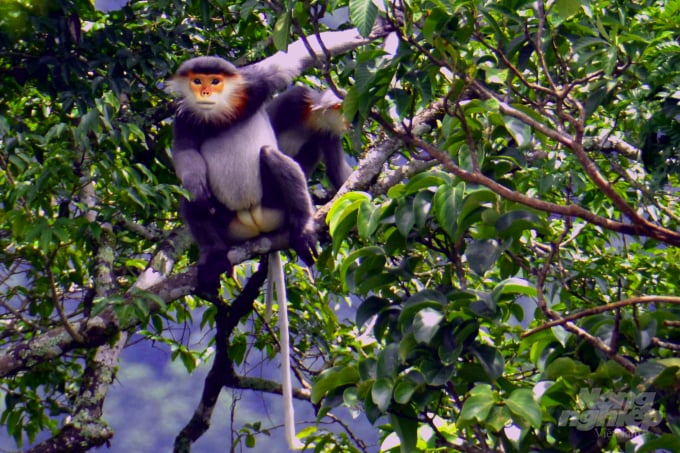
An adult male gray-shanked douc langur in Kon Ka Kinh National Park. Photo: Ai Tam.
“But only a few years after Kon Ka Kinh forest became a national park, we suddenly saw them reappear then a few years later, we began to see images of young langurs clutching their mother's belly, practicing branching, or pregnant langur mothers, with their pregnancy hanging around."
Another good news was that when the Kon Ka Kinh forest was revived, many indigenous people who used to be wild animals "killers", turned to become their protectors.
Mr. Dinh Duong from Dac Jo Ta commune, Mang Yang district, is such a person. Mr. Duong confided that in the past, as the forest was closed, it was normal for locals to go to the forest for hunting. Everyone did the same thing. Duong followed the villagers and his relatives to the forest to hunt wild animals from a very young age, so he did not remember how many animals he had killed.
Gray-shanked douc langurs were among the most killed species, because they were easier to hunt than others, according to Duong.

A herd of gray-shanked douc langurs is playing in Kon Ka Kinh National Park. The leader langur is in charge of guarding the whole herd. Photo: Ai Tam.
When animals in the forest began to run out, it was also time for the forest to be closed. The hunters left their guns and hunting bows in despair. At first, many of them were not happy with the prohibition, still recklessly went to the forest for hunting. But then someone was arrested and fined, others started to fear and falter. What is more important than the law is that they have been aware of the fact that forest is their flesh and blood so if they go to the forest to hunt and cut down trees like that, one day not far away, their children and grandchildren will not know what the forest is. They will have nothing to rely on.
Duong realizes such an ideal after he saw a group of strangers daily crossing the forest and streams to find and take care of each injured wild animal. Then they told him the langurs he had shot were very rare and precious animals, only found in the forests of Vietnam.
Duong's heart was moved, and then he decided to hand over the shotgun to the communal authority, volunteering to follow the research team to support them. After each trip, he always told his relatives what he had seen with his own eyes. Now, no one goes to the forest to hunt animals anymore, particularly the rare langurs.
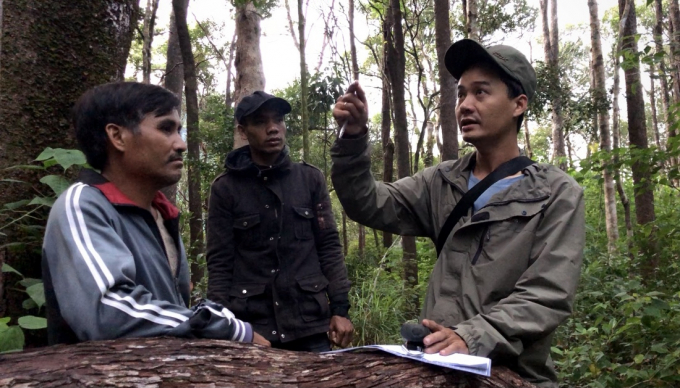
The research team analyze and exchange information on the number and frequency of singing of the gray-shanked douc langur in Kon Ka Kinh National Park. Photo: Hong Thuy.
Like Dinh Duong, Mr. Hjun, from Dak To Ve commune, Mang Yang district, used to be an adept hunter, familiar with KaKon Ka Kinh National Park like the back of his hand. After being recruited by the national park officials and research team members, the local man has become one of the best "news hunters" of the gray-shanked douc langur. Just hearing the langur singing, Hjun can distinguish the langur’s age and gender. Then he can count the sounds of langurs singing to estimate how many langurs there. Every time he enters the forest, just hearing a few rustling sounds in the trees, even though can't see it, but he knows, their curious eyes are following him.
An interesting feature of gray-shanked douc langur unlike any other primate species, released by Tam is that they never drink water as the water for their body is taken from leaves and fruits they eat. Because they do not drink water, they live entirely on trees, never coming to the ground.
As a member of a research group on gray-shanked douc langur since 2006 and knowing clearly about their characteristics and living habits, Ms. Nguyen Thi Tinh said: "The gray-shanked douc langur has just been discovered in 1991, but at that time, they were only treated as a subspecies of red-shanked douc (Pygathrix nemaeus). Until 1997, the German primatologist Tilo Nadler concluded and confirmed that the langur is a separate species with its scientific name as Pygathrix cinerea.

A gray-shanked douc langur discovered he was "followed" when prepared to "escape". Photo: Ai Tam.
The langur is also known locally as the five-colored langur or the douc langur because they wear a "coat" of five colors of which the main ones are gray, alternating white, black, red and orange. On his head is a gray fur hat, with a black line on the forehead. The face stands out with sharp slanted eyes and a beautiful long, white beard, below is a set of orange and red necklaces. Another prominent part of their body is the tail that is longer than the body, white, and extremely beautiful.
Regarding their living habits, Ms. Tinh said that they live in families, also known as the base herd. Each herd has a single male along with 5-6 adult females and their cubs. This type of herd organization is called a monogamous one. Males separated from the base herd may live together or live alone. Sometimes base herds can merge into a large one, from 20 to 40 langurs.

Gray-shanked douc langur is a vulnerable species because it is easy to detect, although it is very intelligent and agile. Photo: Ai Tam.
Their favorite food is young leaves and green fruits.The digestive system of the gray-shanked douc is biologically characteristic of the leaf-eating monkey group (Colobinea), that is, it does not have a food storage bag in the cheeks but has a well-developed salivary gland.
When moving among trees, the langur uses all four limbs or only two front limbs. It is very rare to see them moving with two hind limbs.
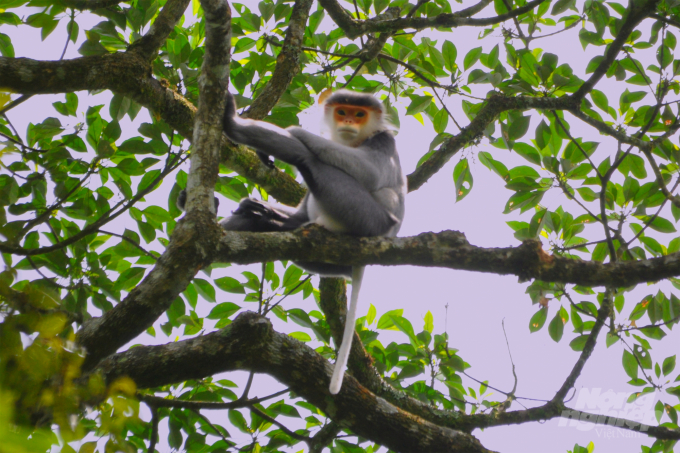
Since the Kon Ka Kinh forest is protected, the gray-shanked douc langur finds its own "world" and reproduces (pictured is a baby one). Photo: Ai Tam.
The langur is very clever. With its special characteristic of always being on a tall tree and guarded by the herd leader, it can detect danger from hundreds of meters away. Therefore, accessing to record information about them is not easy. However, they are a species vulnerable to hunting because when they detect a threat, they often do not run far, but climb up to the tall, dense branches to hide. Because the tail of this species is very long, white, always hanging straight, it is easy to be discovered.
Scientists have investigated the distribution and population of gray-shanked douc langur in the wild since they were discovered as a new species. The results show that this primate is only distributed in a narrow area of Vietnam mostly in the South Central region and the Central Highlands (from Quang Nam to Gia Lai Province). Beside that, no other area in the world has this langur to live.

(VAN) Deputy Minister Nguyen Quoc Tri also expressed his hope that Cuba will soon overcome its current challenges, attain food security, and further expand cooperation with Vietnam.

(VAN) The project contributes to enhancing the resilience of communities vulnerable to the impacts of climate change, with a primary focus on local women.
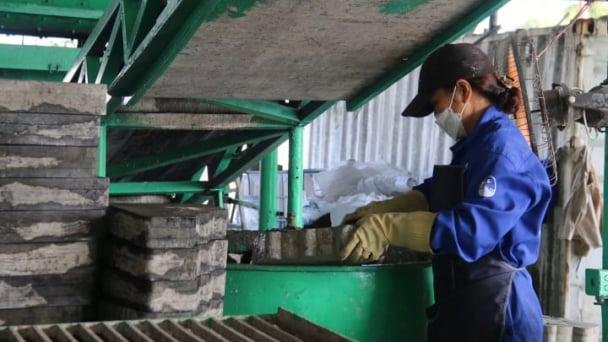
(VAN) Green materials help save energy and resources. However, after more than 10 years, Vietnam has only developed over 200 green buildings with more than 6 million square meters of floor space.

(VAN) Vietnam - Thailand Business Forum 2025: One plus one on three connects, marking a milestone in the comprehensive strategic partnership between the two nations.
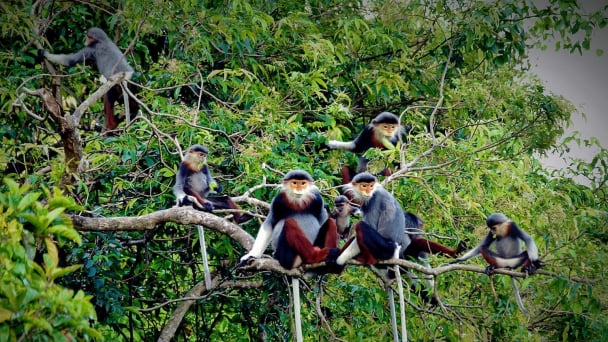
(VAN) The United Nations designated 22 May as the International Day for Biodiversity 2025 with the theme 'Harmony with nature and sustainable development.'
![Multi-channel, multi-directional Vietnamese agricultural markets: [8] A national strategy is needed](https://t.ex-cdn.com/nongnghiepmoitruong.vn/608w/files/phucpm/2025/05/15/1435-thi-truong-nong-san-viet-da-kenh-da-huongbai-8-can-mot-chien-luoc-quoc-gia-084750_728.jpg)
(VAN) The Chairman of Hung Nhon Group shared: ‘Opening up and tapping into new markets is the right and strategic direction for Vietnam's agricultural sector.’

(VAN) Food waste has become a serious issue in modern society, especially in rapidly urbanizing and developing cities like Hanoi.